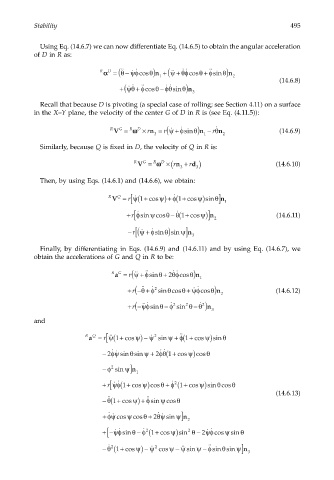Page 514 - Dynamics of Mechanical Systems
P. 514
0593_C14_fm Page 495 Tuesday, May 7, 2002 6:56 AM
Stability 495
Using Eq. (14.6.7) we can now differentiate Eq. (14.6.5) to obtain the angular acceleration
of D in R as:
˙ ˙
˙˙
− ˙ ˙
˙˙
+
R αα=(θ ψφ cosθ )n +( ˙˙ ψ θφ cosθ + sinφ ) θ n
D
1 2
(14.6.8)
˙ ˙
˙˙
+( ˙ ˙ + cosθ φθ sin ) θ n
ψθ φ
−
3
Recall that because D is pivoting (a special case of rolling; see Section 4.11) on a surface
in the X–Y plane, the velocity of the center G of D in R is (see Eq. (4.11.5)):
V = ωω × rn = r( ˙ ψφ n ) θ − θ (14.6.9)
R G R D ˙ ˙
+ sin
r n
3 1 2
Similarly, because Q is fixed in D, the velocity of Q in R is:
V = ωω rn + (14.6.10)
R G R D ×( rd )
3 3
Then, by using Eqs. (14.6.1) and (14.6.6), we obtain:
˙
Q
R V = r ( [ ψ 1 + cosψ ) + ( φ 1 + cosψ )sin n ] θ 1
˙
˙
+ r[ sin cosφ ˙ ψ θ − ( θ 1 + cosψ n )] (14.6.11)
2
+ sinθ
− r ( [ ψφ ˙ )sinψ n ]
˙
3
Finally, by differentiating in Eqs. (14.6.9) and (14.6.11) and by using Eq. (14.6.7), we
obtain the accelerations of G and Q in R to be:
+ sinθ
a =
˙˙
RG r( ˙˙ ψφ + θφ2 ˙ ˙ cosθ n )
1
r( θφ
+ ˙ ˙
˙˙
+− + ˙ 2 sin cosθ ψφ cosθ n ) (14.6.12)
θ
2
r( ˙˙ ˙
+−ψφ sinθ − φ ˙ 2 sin θ − θ ˙ 2 n )
2
3
and
a = r ( [ ψ 1 + cos ψ ) − ˙ sin ψ + ( φ 1 + cos ψ )sinθ
ψ
R Q 2 ˙˙
˙˙
θ
− φψ2 ˙ ˙ sin sin ψ + φθ2 ˙ ˙ (1 + cos ψ )cosθ
− φ 2 sin ψ n ]
1
˙ ˙
+ r[ ψφ (1 + cos ψ )cosθ φ ˙ 2 + cos ψ )sin cosθ θ
+ (1
(14.6.13)
˙˙
˙˙
− ( θ 1 + cos ψ ) + sinφ ψ cosθ
+ φ ˙˙ cos ψ cosθ + 2 θψ
˙
ψ
˙ ˙ sin ψ]n
2
+− [ ψφ sinθ φ (1 + cos ψ) sin θ − 2 ψφ cos ψ sinθ
˙ ˙
˙ ˙
−
2
˙ 2
θ
˙ cos ψ −
− θ (1 + cos ψ) − ψ 2 ψ φ sin sin ψ] n
˙˙
˙˙ sin ψ −
˙ 2
3

